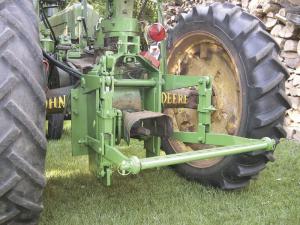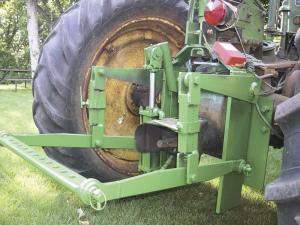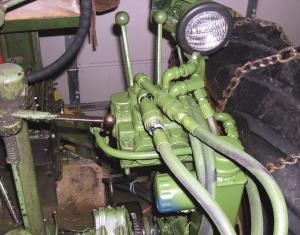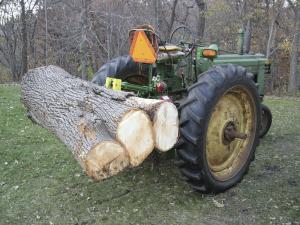2010 - Volume #34, Issue #2, Page #19
[ Sample Stories From This Issue | List of All Stories In This Issue | Print this story
| Read this issue]
Deere "B" Fitted With Powerful 3-Pt. Hitch/Drawbar
 |
 |
 |
 |
"The drawbar can be lowered to ground level or raised 3 ft. high, which makes it easy to drag logs and to lift heavy trailer tongues," says Bipes. "If I want I can use the unit like a conventional 3-pt. hitch by pulling two clip pins to remove the drawbar, and then adding a top cylinder."
A 3 by 8-in. hydraulic cylinder mounted to one side raises or lowers the entire hitch. A 2 by 10-in. cylinder (not installed when the drawbar is used alone) serves as the hitch's top link, and allows any 3-pt. mounted implements to be tilted forward or back.
The 3 by 8-in. lift cylinder pushes against a 1 -in. dia. steel lever that's welded perpendicularly to one end of an identical 1 -in. dia. horizontal steel torsion bar that also provides the main pivot action for a pair of triangle-shaped lift arms.
"In effect, the cylinder acts on two upper arms that lift the two lower arms, and form a parallel linkage. Both upper and lower arms are always parallel to each other as they move up or down," says Bipes.
A pair of linear gear racks, with their teeth held meshed together by clamps with screws and Tee-handles, transmit vertical motion from the upper to the lower arms. "If I want, I can loosen the clamps on the gear racks in order to unmate the teeth. Then I can adjust the distance between the upper and lower arms and thereby offset the 3-pt. implement's height on one or both sides."
The entire unit is built to stand up to 2,500 psi hydraulic pressure, which applies up to 9 tons of torque to the 1 -in. horizontal torsion bar at 4,000 lbs. of drawbar lift. "The pressure is more than enough to lift the front wheels, so I shouldn't have to worry about anything busting the lift actuator mechanism," says Bipes.
"By using the cylinder to force the drawbar to the ground, I can actually lift the tractor's rear wheels off the ground and put on tire chains. However, I learned the hard way that it's safer to place a block under only one side of the hitch and lift only one rear tractor tire at a time.
"I even use the drawbar to crush old scrap metal before I haul it to a scrap yard. One time I used the drawbar to lift the end of my pickup to work on the brakes."
He has a log lifting attachment for the drawbar that'll pick up tree trunks of up to 1,500 lbs. with no problem.
The tractor didn't have any hydraulics, so Bipes welded up brackets to bolt on a hydraulic pump and valve. He used a piece of 2-in. sq. pipe to make a vertical-mounted reservoir and mounted an inexpensive spin-on auto oil filter, model PF-47, on the inside top of the pipe where it's protected from flying tire chains.
"I machined metric threads into a pipe nipple and welded it on to the top side of the pipe," says Bipes. "Oil from the hydraulic pump circulates continuously through the filter, into the perimeter and out through the center like on a car engine, before it goes back into the reservoir. A huge pipe nipple and mating cast iron cap, spun on hand-tight, serves as the hydraulic oil filler hole. A pair of slots û made by milling away a small stretch of the cap's internal pipe threads on each side û effectively creates two inverted U-shaped breathers ventilating the reservoir when the cap is on."
Contact: FARM SHOW Followup, John Bipes, 906 Adams St., Mankato, Minn. 56001 (ph 507 387-3840; mobeng@hickorytech.net).

Click here to download page story appeared in.

Click here to read entire issue
To read the rest of this story, download this issue below or click here to register with your account number.




